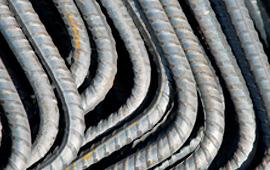Reinforcing Success: The Marvels of Rebar in Construction
Rebar, short for reinforcing bar, is a critical component in modern construction, particularly in concrete structures. Concrete is known for its impressive compressive strength—it can withstand heavy loads pressing down on it. However, it lacks tensile strength, which is the ability to resist forces that attempt to pull it apart. Rebar is used to compensate for this weakness, giving concrete structures the necessary reinforcement to handle tensile and shear stresses.
Typically made from carbon steel and formed into rods with ridges or deformations, rebar bonds well with concrete, allowing the two materials to act as one. The ridges help lock the steel into the concrete, preventing slippage and improving the structure's durability. When embedded into concrete, rebar dramatically increases the lifespan, strength, and safety of buildings, bridges, highways, foundations, and other infrastructure.
In the realm of construction, where strength and durability are paramount, one unsung hero plays a crucial role—rebar. Short for reinforcing bar, rebar is a game-changer that adds a whole new level of resilience to structures. Let's delve into the world of rebar and explore the myriad of benefits it brings to the table.
Strength Amplified:
At its core, construction rebar is all about fortification. It reinforces concrete, providing additional strength to withstand the test of time and the forces of nature. It acts as a backbone, transforming a simple concrete structure into a robust, long-lasting edifice.
Structural Integrity:
One of the primary benefits of incorporating rebar in construction is the enhancement of structural integrity. By strategically placing rebar within the concrete, engineers can mitigate the risks of cracks and fractures, ensuring that the structure remains sound and secure. Rebar is essential in virtually all concrete construction, from small residential slabs to massive skyscraper foundations. It helps control cracking caused by shrinkage or temperature changes and ensures that when cracks do occur, they do not compromise structural integrity. The use of rebar also allows engineers to build taller, stronger, and more complex structures than would be possible with concrete alone.
Flexibility and Versatility:
Rebar comes in various shapes and sizes, making it adaptable to different construction needs. Whether it's a towering skyscraper, a sturdy bridge, or a residential dwelling, rebar for construction can be customized to suit the specific requirements of the project, offering unparalleled flexibility.
Corrosion Resistance:
In the face of environmental challenges, such as exposure to moisture and harsh weather conditions, reinforcing bar construction proves its mettle. Many rebar options are designed with corrosion-resistant coatings, adding an extra layer of defense against the elements and ensuring the longevity of the structure.
Cost-Efficiency:
While the initial cost of incorporating rebar may seem like an investment, the long-term benefits far outweigh the expenses. The increased lifespan of the structure and reduced maintenance costs make rebar a cost-effective choice in the grand scheme of construction projects.
Earthquake Resistance:
In regions prone to seismic activity, rebar becomes a lifeline for structures. Its ability to distribute and absorb stress helps buildings withstand the shaking forces of an earthquake, providing an added layer of safety for occupants.
Types of Rebar
There are several different types of rebar used in construction, each tailored for specific applications:
-
Carbon Steel Rebar: The most commonly used type, offering a balance of strength and affordability.
-
Epoxy-Coated Rebar: Used in environments exposed to moisture and corrosion, such as marine structures and bridge decks.
-
Stainless Steel Rebar: Highly resistant to corrosion and ideal for projects requiring long-term durability, though more expensive.
-
Galvanized Rebar: Coated with a layer of zinc to protect against corrosion.
-
Glass Fiber Reinforced Polymer (GFRP): A non-metallic alternative that doesn't corrode, often used in applications sensitive to electromagnetic interference.
Rebar is the unsung hero that silently but significantly contributes to the strength and resilience of our built environment. As we marvel at towering structures and sturdy bridges, let's not forget to acknowledge the role of rebar—the backbone that turns architectural dreams into enduring realities. Rebar is a hidden but vital element in construction. By reinforcing concrete's weak points, it ensures the safety, longevity, and resilience of the built environment, making it indispensable in today's infrastructure and architectural projects.

